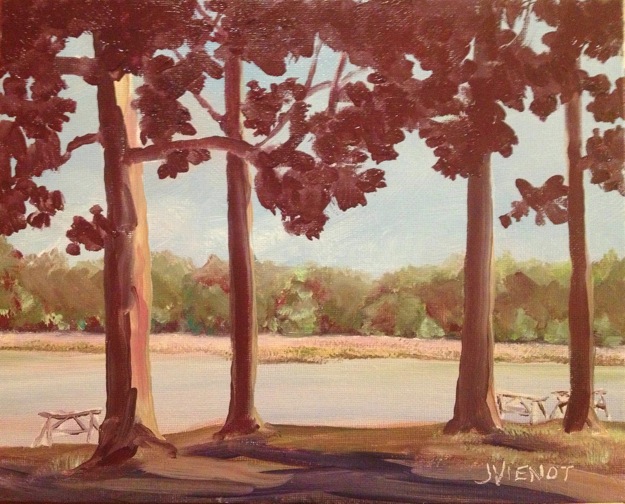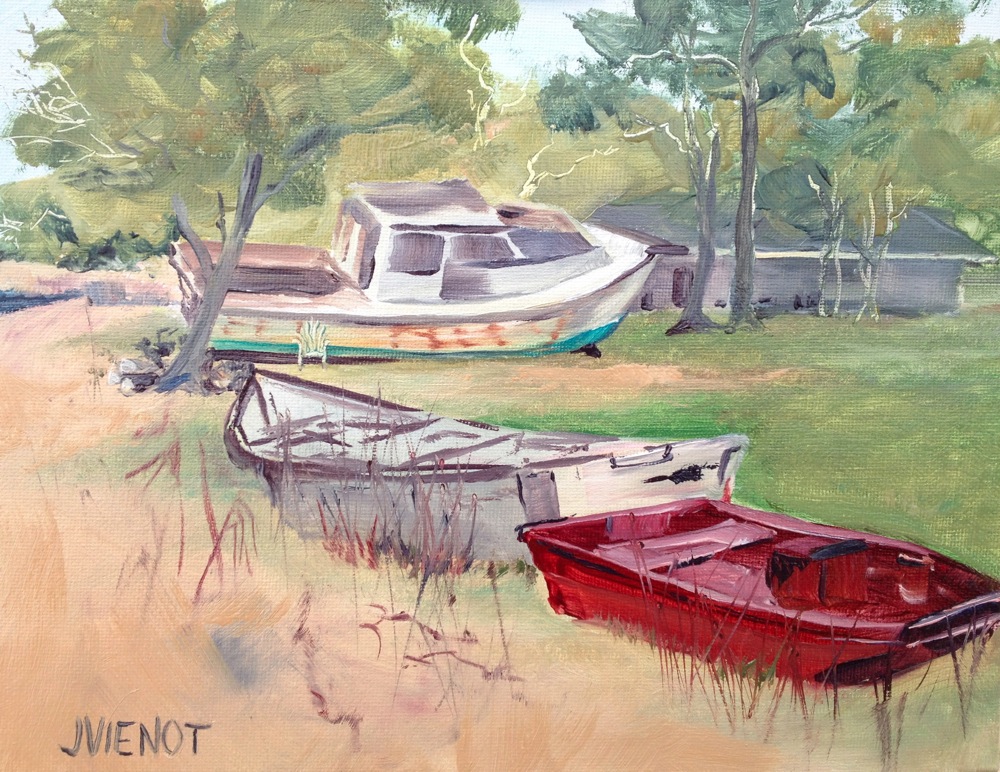

Those who follow my blog know that I contract to paint plein air at wedding receptions at Grayt Grounds of Monet Monet where my plein air paintings are shown. I blogged about it in May, “Commissioned Works en Plein Air.” So you might think it would become old hat, painting the same setting. But the colors are different, the sounds change, the plants change, the people are different, and most of all, the light changes, so the challenges are always there, and I must always grow as a result. If the scene feels too familiar, all I need to do is move my easel a little, or turn my head, for a new point of view. I am not so fast as to actually paint the couple on site — instead I paint the surroundings in the hour before the event, and then I take photos and sketch a gesture of their entrance or first dance or whatever scene they choose, and then I may block in the general silhouette of the couple. I complete the painting in the studio. The biggest challenge, in commissioned work, of course is pleasing the client, and that includes working with color choices that compliment or repeat the design colors of the event, and sometimes it includes altering my painting style to lean towards a particular style the client likes.

My most recent contract was a month ago, in September. I had gotten the time wrong, thinking the newly wedded couple would be making their entrance around 5:30 instead of 7:30, so I was painting the entire back scene with late afternoon light in preparation for adding the couple when they made their entrance. I had planned to catch the couple coming across the bridge over the coy pond, placing them slightly right of center, against the spray of the green bamboo like plant that grows behind the bridge.
When the couple made their entrance at 7:30, my entire painting was wrong — the garden was now illuminated by string lights instead of afternoon sunlight. Plan B: Start a second painting!!! I was only minimally prepared for a nocturne, but I needed to get my painter’s sense of the location, the sounds, the vibrancy of the lights, the energy of the party. By painter’s sense, I mean that visceral impression of myself being a participant in the scene and not just an observer. I needed to be able to recall all of it, not just relying on photo references, which convey only a small part of what I try to project. I set up my little lights, one on my palette and one on my painting, and knocked out a study of the light-wrapped trees and the dance patio to help me do the job right when I got back to the studio.

The challenges of painting a nocturne successfully include first of all, believable colors. My palette from the afternoon painting was not the colors I would have chosen if I had planned a nocturne, but I was under the gun to capture the light-wrapped trees and the energy of the gardens so I used my afternoon palette. I don’t judge the resulting study — it has so much background energy, it looks like the place is on fire — it was perfect for reminding me of some of the feeling I needed to capture, even though I needed to figure out how to paint the light-wrapped trees better.
A little about composition… When I teach, I suggest that my students stick to the safer “rule of thirds” for the focal point, which means putting the focus of the painting on one of the intersections of the horizontal and vertical tri-sections of the painting. By putting the couple smack in the middle of the painting, I was challenged to direct the viewer’s eye. I didn’t want the eye to go straight to the center and just stay there. I wanted the eye to circle the painting, returning again and again to center, to help the viewer look at the painting for a longer period of time. That required more attention to the crowd than I was visualizing at the actual event, and especially more attention to the figures at the outside edges, who are intended to help the eye circle, and by their body position also help redirect the attention back to center. The scene is dramatized by the blue and red spotlights that were on the couple during their First Dance.
By writing this, I am reminded how many decisions go into making a painting. When painting plein air, those decisions are made on the fly; they are more considered in the studio. To arrange for me to paint plein air at your event, contact Cheri Peebles at Grayt Grounds: http://graytgrounds.com/contact/.




















